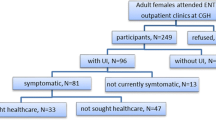Abstract
The purpose of this study was to assess the prevalence of female urinary incontinence (UI) and risk factors of bothersomeness and help-seeking behavior of hidden female UI in urology and obstetrics and gynecology outpatient clinics. This multicentric and cross-sectional study was conducted as a part of the Turkish Overactive Bladder Study. Female patients (n = 5,565) who were referred with complaints other than UI and overactive bladder symptoms were surveyed using the International Consultation on Incontinence Questionnaire Short Form (ICIQ-SF) with supplementation of five more questions. The crude prevalence of UI was found to be 35.7%. The prevalence of frequent and severe incontinence was 8.2 and 6.8%, respectively. The mean age of incontinent patients was significantly higher (p < 0.001). The prevalence of stress, urge, and mixed UI was 39.8, 24.8, and 28.9%, respectively. More than half (53%) of incontinent patients were not bothered by UI, and only 12% of incontinent patients had previously sought medical help for their problem. Frequency, severity, and type of UI were independent factors for predicting bothersome UI, while only bothersomeness increased help-seeking behavior. The ICIQ-SF score of 8 has been found to be the best cutoff value to delineate the bothersome UI. Although the crude prevalence of female UI was found to be high, bothersome UI was not so common. The majority of incontinent female patients did not seek medical help. Frequency, severity, and mixed type of UI were found to be the determinants of bothersome UI for which the ICIQ-SF cutoff score of 8 was obtained.
Similar content being viewed by others
References
Bates P, Bradley WE, Glen E, Griffiths D, Melchior H, Rowan D, Sterling A, Zinner N, Hald T (1979) The standardization of terminology of lower urinary tract function. J Urol 121:551–554
Abrams P, Cardozo L, Fall M, Griffiths D, Rosier P, Ulmsten U, van Kerrebroeck P, Victor A, Wein A (2002) The standardisation of terminology of lower urinary tract function: report from the standardisation sub-committee of the International Continence Society. Neurourol Urodyn 21:167–178
Minassian VA, Drutz HP, Al-Badr A (2003) Urinary incontinence as a world wide problem. Int J Gynecol Obstet 82:327–338
Nygaard IE, Lemke JH (1996) Urinary incontinence in rural older women: prevalence, incidence and remission. J Am Geriatr Soc 44:1049–1054
Thom DH, Nygaard IE, Calhoun EA (2005) Urologic diseases in America project: urinary incontinence in women-national trends in hospitalizations, office visits, treatment and economic impact. J Urol 173:1295–1301
Hunskaar S, Arnold E, Burgio K, Diokno AC, Herzog AR, Mallett VT (1999) Epidemiology and natural history of urinary incontinence. In: Abrams P, Khoury S, Wein AJ (eds) Incontinence. Health Publications, London, pp 199–226
Hunskaar S, Burgio K, Diokno AC, Herzog AR, Hjalmas K, Lapitan MC (2003) Epidemiology and natural history of urinary incontinence in women. Urology 62:16–23
Thom D (1998) Variation in estimates of urinary incontinence prevalence in the community: effects of differences in definition, population characteristics, and the study type. J Am Geriatr Soc 46:473–480
Sandvik H, Seim A, Vanvik A, Hunskaar S, Sandvik A (2000) Severity index for epidemiological surveys of female urinary incontinence: comparison with 48-hour pad-weighing tests. Neurourol Urodyn 19:137–145
Andersson G, Johansson JE, Garpenholt O, Nilsson K (2004) Urinary incontinence—prevalence, impact on daily living and desire for treatment. Scand J Urol Nephrol 38:125–130
Cetinel B, Ozkan B, Can G (2004) The validation study of ICIQ-SF Turkish version. Turkish J Urol 30:332–338
Alnaif B, Drutz HP (2001) The prevalence of urinary and fecal incontinence in Canadian secondary school teenage girls: questionnaire study and review of the literature. Int Urogynecol J 12:134–138
Hajebrahimi S, Corcos J, Lemieux CM (2004) International consultation on incontinence questionnaire short form. Comparison of physician versus patient completion and immediate and delayed self-administration. Urology 63:1076–1078
Sandvik H, Hunskaar S, Vanvik A, Bratt H, Seim A, Hermstad R (1995) Diagnostic classification of female urinary incontinence: an epidemiologic survey corrected for validity. J Clin Epidemiol 48:339–343
Kocak I, Okyay P, Dundar M, Erol H, Beser E (2005) Female urinary incontinence in the west of Turkey: prevalence, risk factors and impact on quality of life. Eur Urol 48:634–641
Hannestad YS, Rortveit G, Sandvik H, Hunskaar S (2000) A community-based epidemiological survey of female urinary incontinence: the Norwegian EPINCONT Study. J Clin Epidemiol 53:1150–1157
Hunskaar S, Burgio K, Clark A, (2004) Epidemiology of faecal and urinary incontinence and pelvic organ prolapse. In: Abrams P, Cardozo L, Khoury S, Wein A (eds) Incontinence, 3rd edn. Health Publications, Plymouth, pp 255–312
Swithinbank LV, Donovan JL, du Heaume JC, Rogers CA, James MC, Yang Q, Abrams P (1999) Urinary symptoms and incontinence in women: relationship between occurrence, age, and perceived impact. Br J Gen Pract 49:897–900
Hannestad YS, Rortveit G, Hunskaar S (2002) Help-seeking and associated factors in female urinary incontinence. The Norwegian EPINCONT Study. Scand J Prim Health Care 20:102–107
Acknowledgement
We express our sincere gratitude for the organizational support of Er-Kim Pharmaceuticals, Turkey (the distributor company of Dr. R. Pfleger GmbH, Germany).
Author information
Authors and Affiliations
Corresponding author
Rights and permissions
About this article
Cite this article
Cetinel, B., Demirkesen, O., Tarcan, T. et al. Hidden female urinary incontinence in urology and obstetrics and gynecology outpatient clinics in Turkey: what are the determinants of bothersome urinary incontinence and help-seeking behavior?. Int Urogynecol J 18, 659–664 (2007). https://doi.org/10.1007/s00192-006-0223-6
Received:
Accepted:
Published:
Issue Date:
DOI: https://doi.org/10.1007/s00192-006-0223-6



